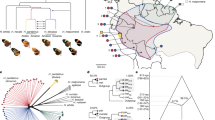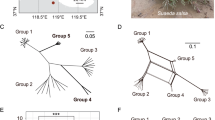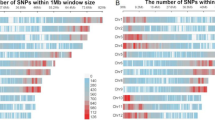Abstract
Several fertile diploid plant species have been shown to be derived from hybridization between species with strong chromosomal sterility barriers, yet little is known about the genomic processes that accompany this mode of speciation. As a first step toward understanding these processes we have generated a detailed genetic linkage map for Helianthus anomalus, a diploid species derived via hybridization between H. annum and H. petiolaris. This was generated using 161 RAPD loci and one isozyme locus. The genetic markers were distributed into 18 linkage groups and cover 2338 cM. Analysis of the parental origin of each locus/allele revealed that 44 were originally derived from H. annuus, 37 were derived from H. petiolaris, 54 could have been derived from either parent, and 25 were unique to H. anomalus. In addition, the parental linkage groups were not transmitted or retained intact in the hybrid species. Rather, molecular markers originating from both parental species were interspersed within individual H. anomalus linkage groups. Although there are several limitations to analysing hybrid genomic composition using this approach, these results do raise the possibility that diploid hybrid species may be able to retain different portions and/or proportions of their parental species' genomes. This characteristic may provide diploid hybrid species with greater flexibility than allopolyploid species in terms of optimizing their genomes for a new ecological niche and may permit the production of several different diploid hybrid species from the same two parents, as appears to have happened in Helianthus.
Similar content being viewed by others
Article PDF
References
Beckstrom-Sternberg, S, Rieseberg, L H, and Doan, K. 1991b. Gene lineage analysis of populations of Helianthus niveus and H. petiolaris. Pl Syst Evol, 175, 125–138.
Bonierbale, M W, Plaisted, R L, and Tanksley, S D. 1988. RFLP maps based on a common set of clones reveal modes of chromosomal evolution in potato and tomato. Genetics, 120, 1095–1103.
Chandler, J M, Jan, C, and Beard, B H. 1986. Chromosomal differentiation among the annual Helianthus species. Syst Bot, 11, 353–371.
Dorado, O, Rieseberg, L H, and Arias, D. 1992. Chloroplast DNA introgression in southern California sunflowers. Evolution, 46, 566–572.
Doyle, J J, and Doyle, J L. 1987. A rapid DNA isolation procedure for small amounts of fresh leaf tissue. Phyto chem Bull, 19, 11–15.
Ferriera, V. 1980. Introgressive hybridization between Helianthus annuus L. and Helianthus petiolaris Nutt. Mendeliana, 4, 81–93.
Gebhardt, C, Ritter, E, Debener, T, Schachtschabel, U, Walkemeier, B, Uhrig, H, and Salamini, F. 1989. RFLP analysis and linkage mapping in Solanum tuberosum. Theor Appl Genet, 78, 65–75.
Gerassimova, H. 1939. Chromosome alterations as a factor of divergence of forms. I. New experimentally produced strains of C. tectorum which are physiologically isolated from the original forms owing to reciprocal translocations. Compt Rend Acad Sci URSS, 25, 148–154.
Grant, V. 1958. The regulation of recombination in plants. Cold Spring Harbor Symposia Quant Biol, 23, 337–363.
Grant, V. 1963. The Origins of Adaptations. Columbia University Press, New York.
Grant, V. 1966a. Selection for vigor and fertility in the progeny of a highly sterile species hybrid in Gilia. Genetics, 53, 757–775.
Grant, V. 1966b. The origin of a new species of Gilia in a hybridization experiment. Genetics, 54, 1189–1199.
Havey, M J, and Muehlbauer, F J. 1989. Linkages between restriction fragment length, isozyme, and morphological markers of lentil. Theor Appl Genet, 77, 395–401.
Heiser, C B. 1947. Hybridization between the sunflower species Helianthus annuus and H. petiolaris. Evolution, 1, 249–262.
Heiser, C B. 1958. Three new annual sunflowers (Helianthus) from the southwestern United States. Rhodora 60, 271–283.
Heiser, C B, Smith, D M, Clevenger, S, and Martin, W C. 1969. The North American sunflowers (Helianthus). Mem Torrey Bot Club, 22, 1–218.
Helentjaris, T, Weber, D F, and Wright, S. 1988. Duplicate sequences in maize and identification of their genomic locations through restriction fragment length polymorphisms. Genetics, 118, 355–363.
Lander, E S, Green, P, Abrahamson, J, Barlow, A, Daly, M J, Lincoln, S E, and Newbury, L. 1987. MAPMAKER: An interactive computer package for constructing primary genetic maps of experimental and natural populations. Genomics, 1, 174–181.
Landry, B S, Hubert, N, Etoh, T, Harada, J J, and Lincoln, S E. 1991. A genetic map for Brassica napus based on restriction fragment length polymorphisms detected with expressed DNA sequences. Genome, 34, 543–552.
McCouch, S R, Kochert, B, Yu, Z H, Wang, Z Y, Khush, G S, Coffman, W R, and Tanksley, S D. 1988. Molecular mapping of rice chromosomes. Theor Appl Genet, 76, 815–829.
Nabhan, G P, and Reichhardt, K L. 1983. Hopi protection of Helianthus anomalus, a rare sunflower. Southwest Nat, 28, 231–235.
Oliveri, A M, and Jain, S K. 1977. Variation in the Helianthus exilis-bolanderi complex. Madrono, 24, 177–189.
Rieseberg, L H. 1991a. Homoploid reticulate evolution in Helianthus: Evidence from ribosomal genes. Am J Bot, 78, 1218–1237.
Rieseberg, L H. 1991b. Hybridization in rare plants: insights from case studies in Helianthus and Cercocarpus. In: Falk, D. A. and Holsinger, K. E. (eds) Conservation of Rare Plants: Biology and Genetics, Oxford University Press, Cambridge, pp. 171–181.
Rieseberg, L H, Beckstrom-Sternberg, S, and Doan, K. 1990a. Helianthus annuus ssp. texanus has chloroplast DNA and nuclear ribosomal RNA genes of Helianthus debilis ssp. cucumerifolius. Proc Natl Acad Sci, USA, 87, 593–597.
Reiseberg, L H, Beckstrom-Sternberg, S, Liston, A, and Arias, D. 1991a. Phylogenetic and systematic inferences from chloroplastDNA and isozyme variation in Helianthus sect. Helianthus (Asteraceae). Syst Bot, 16, 50–76.
Rieseberg, L H, Carter, R, and Zona, S. 1990b. Molecular tests of the hypothesized hybrid origin of two diploid Helianthus species. Evolution, 44, 1498–1511.
Rieseberg, L H, Choi, H, and Ham, D. 1991b. Differential cytoplasmic versus nuclear gene flow in Helianthus. J Hered, 82, 489–493.
Rieseberg, L H, and Seiler, G. 1990. Molecular evidence and the origin and development of the domesticated sunflower (H. annuus L.). Econ Bot, 44, 79s–91s.
Rieseberg, L H, Soltis, D E, and Soltis, P S. 1988. Genetic variation in Helianthus annuus and H. bolanderi. Bio chem Syst Ecol, 16, 393–399.
Schilling, E E, and Heiser, C B. 1981. An infrageneric classification of Helianthus (Compositae). Taxon, 30, 393–403.
Slocum, M K, Figdore, S S, Kennard, W C, Suzuki, J Y, and Osborn, T C. 1990. Linkage arrangement of restriction fragment length polymorphism loci in Brassica oleracea. Theor Appl Genet, 75, 784–794.
Smith, H H, and Daly, K. 1959. Discrete populations derived by interspecific hybridization and selection in Nicotiana. Evolution, 13, 476–487.
Soltis, P S, Doyle, J J, and Soltis, D E. 1992. Molecular data and polyploid evolution in plants. In: Soltis, P. S., Doyle, J. J., and Soltis, D. E. (eds) Molecular Systematics of Plants, Chapman&Hall, New York, pp. 177–201.
Song, K M, Osborn, T C, and Williams, P H. 1988. Brassica taxonomy based on nuclear restriction fragment length polymorphisms (RFLPs). 1. Genome evolution of diploid and amphidiploid species. Theor Appl Genet, 75, 784–794.
Song, K M, Suzuki, J Y, Slocum, M K, Williams, P H, and Osborn, T C. 1991. A linkage map for Brassica rapa (syn. campestris) based on restriction fragment length polymorphism loci. Theor Appl Genet, 82, 296–304.
Stebbins, G L. 1957. The hybrid origin of microspecies in the Elymus glaucus complex. Cytologia, Suppl. Vol., pp. 336–340.
Suiter, K A, Wendel, J F, and Case, J S. 1983. Linkage-1: A Pascal computer program for the detection and analysis of genetic linkage. J Hered, 74, 203–204.
Tanksley, S D, Bernatsky, R, Lapitan, N L, and Prince, J P. 1988a. Conservation of gene repertoire but not gene order in pepper and tomato. Proc Natl Acad Sci, USA, 85, 6419–6423.
Tanksley, S D, Miller, J, Paterson, A, and Bernatsky, R. 1988b. Molecular mapping of plant chromosomes. In: Gustafson, J. P. and Appels, R. (eds) Chromosome Structure and Function, Plenum Press, New York, pp. 157–173.
Williams, J K G, Kubelik, A R, Livak, K J, Rafalski, J A, and Tingey, S V. 1990. DNA polymorphisms amplified by arbitrary primers and useful genetic markers. Nucl Acids Res, 18, 6531–6535.
Young, N D, and Tanksley, S D. 1989. Restriction fragment length polymorphism maps and the concept of graphical genotypes. Theor Appl Genet, 77, 95–101.
Acknowledgements
We would like to thank Oscar Dorado, Peter Fritsch, Rhonda Rieseberg, Stan Spencer, and Richard Whitkus for their critical reading of the manuscript. This research was supported by National Science Foundation Grant BSR-8722643 to LHR.
Author information
Authors and Affiliations
Rights and permissions
About this article
Cite this article
Rieseberg, L., Choi, H., Chan, R. et al. Genomic map of a diploid hybrid species. Heredity 70, 285–293 (1993). https://doi.org/10.1038/hdy.1993.41
Received:
Issue date:
DOI: https://doi.org/10.1038/hdy.1993.41
Keywords
This article is cited by
-
High-throughput genotyping-by-sequencing facilitates molecular tagging of a novel rust resistance gene, R 15 , in sunflower (Helianthus annuus L.)
Theoretical and Applied Genetics (2018)
-
De novo sequencing of sunflower genome for SNP discovery using RAD (Restriction site Associated DNA) approach
BMC Genomics (2013)
-
Defining the sunflower (Helianthus annuus L.) linkage group ends with the Arabidopsis-type telomere sequence repeat-derived markers
Chromosome Research (2006)
-
Identification and mapping of SNPs from ESTs in sunflower
Theoretical and Applied Genetics (2005)
-
The self-incompatibility locus (S) and quantitative trait loci for self-pollination and seed dormancy in sunflower
Theoretical and Applied Genetics (2005)



